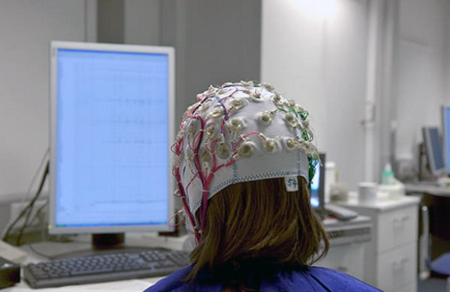What is dysmenorrhea (period cramps), what are the causes and how to treat it?


Dysmenorrhea (painful menstruation) is familiar to more than 50% of women. This is the name of a pathological condition when on the first day of menstruation there are severe aching or stabbing pains in the lower abdomen. Many women believe that this condition is natural and inevitable. So they take pain relievers during their period without realizing that the pain can be a symptom of a gynecological disease that requires treatment.
Dysmenorrhea can be of two types: primary and secondary. The first one occurs in girls and women aged 13-25 years and is a consequence of a violation of the synthesis of hormonal substances.
Secondary dysmenorrhea is more dangerous, it occurs in women 30-35 years old on the first day of the cycle and ends with the end of menstruation. On these days, patients feel dizzy, aching in the back, sometimes fainting, there is a decrease in a working capacity.
Key points about dysmenorrhea
Primary: within a year and half of the first menstrual period
Secondary: at any time
The causes of this type of dysmenorrhea can be diseases such as:
- Myoma (fibroids) of the uterus;
- Endometriosis;
- Inflammatory processes in the genitals;
- Other gynecological diseases.
What is dysmenorrhea?
Dysmenorrhea is a violation of the female cycle manifested by a nagging pain in the lower abdomen in the first days of menstruation. The pain can be mild or intense. This condition occurs in women of reproductive age.
Why dysmenorrhea occurs?
There are several theories about dysmenorrhea. But all doctors agree that there are certain factors that can promote the condition:

- Early-onset of the first menstruation;
- Chronic lack of sleep;
- Regular stressful situations;
- Tobacco smoking;
- Chronic gynecological diseases;
- Hormonal imbalance;
- Genetic predisposition.
A painful period can be a variant of the norm for a particular woman or indicates hidden problems in the body. Dysmenorrhea is typical for adolescents when a young body is just developing under the influence of female sex hormones.
How to recognize dysmenorrhea?

Period cramps have certain peculiarities that help distinguish dysmenorrhea from other conditions. First of all, notice when the discomfort begins. With dysmenorrhea, pain appears a few days before the onset of menstruation and lasts 2-3 days. The physical discomfort can be accompanied by:
- Emotional and mental symptoms: irritability, mood swings, depression, drowsiness, insomnia, eating disorders (bulimia or anorexia), etc.;
- Vegetative: nausea, belching, hiccups, chills, fever, sweating, hyperthermia, dry mouth, frequent urination, tenesmus, bloating;
- Vegetative-vascular: fainting, headache, dizziness, rapid or irregular heartbeat, pain in the heart, numbness in the arms and legs, swelling of the eyelids, face;
- Metabolic endocrine: vomiting, feeling of "cotton feet", general severe weakness, itching of the skin, joint pain, edema.
According to the severity, dysmenorrhea is divided into:
- I degree is characterized by moderate pain during menstruation without systemic symptoms, in which performance is not impaired and the use of analgesics is not necessary;
- II degree is characterized by severe pain during menstruation, which is accompanied by some metabolic endocrine and nervous system disorders, impaired performance, and the need to use analgesics;
- III degree is characterized by severe (sometimes unbearable) pain during menstruation, a complex of metabolic-endocrine and nervous system symptoms, complete disability. With this degree of dysmenorrhea, the use of analgesics is ineffective.
Other symptoms of dysmenorrhea

The severity of dysmenorrhea is distinguished not only by the severity of the pain syndrome but the degree of autonomic nervous system (ANS) involvement in the symptoms occurrence and the level of emotional perception. According to the recent study, almost in all surveyed women dysmenorrhea, i.e. period cramps, was accompanied by discomfort from the emotional and nervous system’s parts. The symptoms on the part of the nervous system included nausea and vomiting (77%), dizziness (76%), general weakness (72%), and headache (58%). Among the symptoms on the part of the mental, emotional sphere, the first place by complaints occupied irritability (67%). Every third woman reported such symptoms as tearfulness, feeling of loneliness, and anxiety. With a similar frequency, women showed a decrease in working capacity.
Causes of dysmenorrhea development
The prerequisites for the development of primary dysmenorrhea, which develops from the first menstruation or within 1 - 1.5 years after, are:
- Hypoestrogenism (low level of estrogens),
- Insufficiency of the luteal phase,
- Insufficient level of endogenous opiates (endorphins, enkephalins),
- Functional insufficiency of tissue proteolytic enzymes of the endometrium and impaired fragmentation of the exfoliated uterine mucosa,
- Hypertonicity of the isthmus,
- Hyperreflexia of the uterus,
- Deficiency of prostaglandins due to the inferiority of lipid peroxidation.
The causes of primary dysmenorrhea are not fully understood. There are several theories for its development. But all of them agree that female sex hormones - estrogens and progesterone - are always involved in the pathological process.
In order to understand the nature of dysmenorrhea occurrence, we should understand what changes occur in a woman’s body before and during endometrial rejection, i.e. menstruation.

The effect of estrogens in different phases of the menstrual cycle correlates with the level of progesterone. In the follicular phase, with a low level of progesterone and estradiol, beta-adrenergic receptors are sensitized. Under these conditions, catecholamines reduce the contractility of the uterus. An increase in progesterone levels to values characteristic of the full-fledged luteal phase of the cycle is accompanied by sensitization of alpha-adrenergic receptors. The effect of catecholamines on alpha-adrenergic receptors is manifested by increased uterine contractility, which is highest on menstrual days. A natural premenstrual change in the ratio of steroids leads to an increase in the permeability of cell membranes, mobilization of calcium ions, activation of enzyme synthesis, a change in the rate of oxidation of free fatty acids, an increase in the release of oxytocin, vasopressin, bradykinin, and many other substances. This promotes the ischemia and hypoxia of the myometrium, and endometrial rejection occurs. In the focus of tissue damage, neurogenic inflammation develops, which changes the sensitivity and phenotype of pain receptors. This expands the range of irritants that can activate pain receptors.
Some researchers point out that in the genesis of dysmenorrhea, an increase in the concentration of estradiol against the background of reduced secretion of progesterone is of primary importance. Others are convinced that the appearance of painful menstruation is possible only against the background of anovulatory menstrual cycles.
The authors of the above study note that in patients with mild dysmenorrhea, the steroid profile is often characterized by a normal ratio of estradiol and progesterone, and a feature of the autonomic nervous system's response is a mixed version of autonomic support.

Electroencephalographic data in these patients indicate the predominance of general cerebral changes with signs of dysfunction of certain structures of the brain.
In patients with moderate dysmenorrhea, the steroid profile is more often characterized by normal estradiol production, which is not compensated by the corresponding effect of progesterone in the second phase of the menstrual cycle. In this group, usually, patients with numerous manifestations of irritation of the sympathetic tone of the autonomic nervous system prevail. The electroencephalogram (EEG) of patients displays general cerebral changes with signs of dysfunction of the median-stem structures of the brain.
In patients with severe dysmenorrhea, the level of estradiol exceeds the norm parameters, although the content of progesterone may correspond to the norms of the luteal phase of the menstrual cycle. In such patients, in addition to pain, signs of the autonomic nervous system's parasympathetic influence predominate, which are manifested on the EEG of general cerebral changes with signs of diencephalic-stem structures of the brain.
The authors believe that the analysis of the results of the NSAID test, supplemented with knowledge about the electrophysiological state of the brain (EEG) and the features of vegetative neurotic and psychoemotional reactions, will allow the doctor to decide on the type of therapeutic effect and ensure a sufficiently stable positive effect of dysmenorrhea treatment.
Diagnosing period cramps cause
Diagnosis and differential diagnosis of dysmenorrhea should be aimed, first of all, at the exclusion of extragenital and gynecological pathology, accompanied by acute pain, including during menstruation. These are, first of all, acute cholecystitis, appendicitis, acute pyelonephritis. Unfortunately, medical errors in assessing a patient's condition during menstruation are quite common among doctors of various specialties, and may be the reason for a delay in providing the necessary assistance.
To establish the causes of dysmenorrhea, a thorough examination of the patient is necessary. The following diagnostic methods are advised:

- Conducting a test with non-steroidal anti-inflammatory drugs
- Gynecological examination;
- General blood, urine, blood biochemistry tests;
- Determination of the content of estrogens and progesterone in the blood plasma in the days preceding the expected menstruation (23-25 days with a 28-day menstrual cycle) and magnesium;
- Consultations of related specialists;
- Ultrasound of the pelvic organs (for patients with primary dysmenorrhea, a decrease in the linear dimensions and volume of the uterus, a delay in the secretory transformation of the endometrium, an increase in the volume of the ovaries due to a slowdown in the reduction of the corpus luteum and multifolicular ovaries, a decrease in vascularization of the endometrium and subendometrial layer, an increase in the resistance index in the uterine arteries and their branches is typical);
- Ultrasound of the abdominal organs;
- Hysteroscopy and laparoscopy (if necessary);
- Electroencephalography;
- Bacteriological, microscopic examination of the contents of the vagina and the cervical canal (if signs of inflammation are detected).
An important role for the correct diagnosis of the underlying cause plays the study of the patient’s history, particularly, gynecological history, menstrual cycle features, previous pregnancies and abortions, heredity, and others.
Besides, a doctor should collect the information about the pain character such as its intensity, type (nagging, acute, etc.), localization, time of onset, and disappearance whether it can be reduced with NSAIDs, and so on.
Dysmenorrhea treatment

The main method of painful period treatment is drug treatment aimed at the normalization of the menstrual cycle and lowering of prostaglandins (lipids forming at sites of tissue damage altering pain perception). Treatment is chosen individually based on the identified peculiarities.
The main drugs used for period cramps are:
- hormonal drugs (contraceptives and gestagens, for instance, Duphaston),
- Non-steroidal anti-inflammatory drugs,
- Means of symptomatic therapy (antispasmodics, analgesics),
- Phytopreparations (collections of herbs, including centaury, yarrow, lemon balm, etc.),
- Sedatives in accordance with the expression of symptoms (from herbal preparations to tranquilizers),
- Reflexology, including acupressure, acupuncture, etc.,
- Physiotherapy exercises, breathing exercises, normalizing blood circulation and functional activity of the abdominal and pelvic organs,
- Vitamin therapy,
- Psychotherapeutic assistance that affects the reactive component of pain.
Combined oral contraceptives or oral birth control are effective in treating dysmenorrhea. The therapeutic effect is provided by the suppression of the hormonal function of the ovaries, which leads to anovulation (lack of ovulation). As a result of a decrease in estrogen production, the synthesis of prostaglandins, oxytocin, vasopressin decreases, which in combination leads to a decrease in the tone of the uterus, intrauterine pressure, causing the elimination of pain.
Please note that this article is for information only. You can buy medications such as Duphaston used for the treatment of period cramps at our online drugstore without a prescription and at a lower price than at a regular drugstore but you should first undergo a thorough examination and use only those drugs that your doctor prescribes you.
Post is made based on the information provided by: Karen Willson, gynecologist at Mother and Baby Centre, London, UK
(Updated at Apr 13 / 2024)
Duphaston articles:
Some of the trademarks used in this Web Site appear for identification purposes only.
All orders are reviewed by a licensed physician and pharmacist before being dispensed and shipped.
The statements contained herein are not intended to diagnose, treat, cure or prevent disease. The statements are for informational purposes only and is it not meant to replace the services or recommendations of a physician or qualified health care practitioner. If you have questions about the drugs you are taking, check with your doctor, nurse, or pharmacist.